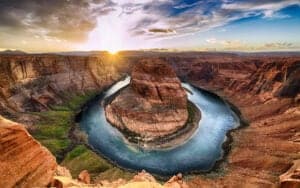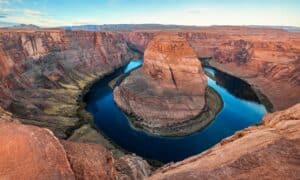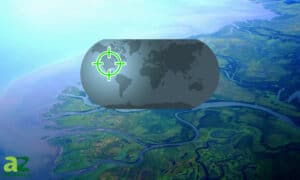How Deep Is The Colorado River?
The “Lifeline of the Southwest,” as it is known, the Colorado River is the sixth-longest river in the U.S. It rises in the Colorado and Wyoming snowcapped mountains and provides hydroelectric power and water for about 40 million people in the United States and Mexico. Due to its purpose for so many uses, it is also considered one of the world’s most heavily regulated rivers.
Tourists sailing along the Colorado River constantly ask the Grand Canyon river guides a recurring question; “How deep is the Colorado River?” It sounds like a simple question, but the answer has always remained unknown as researchers and scientists still debate over the river’s actual depth.
For today’s article, we’re going to delve deeper into one of the most important rivers in the country and will try to discuss how deep it is as well as its history, wildlife, and other unique features.
What is the actual depth of the Colorado River?
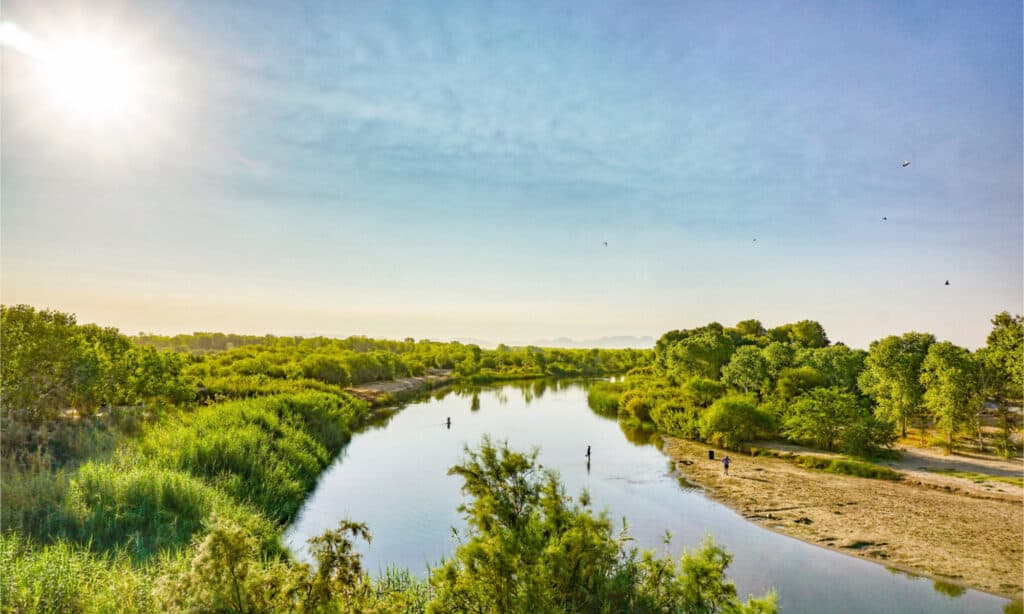
Enrique Alcala/Shutterstock.com
Researchers and scientists are still trying to come up with more definitive conclusions about the Colorado River’s depth. Even the Grand Canyon river guides couldn’t come up with an answer when tourists asked them the question. When people look up the internet, the responses vary based on the year and how truthful the information is. New studies suggest more accurate solutions based on the actual depth of the river.
It is said that the average depth of the Colorado River is about 20 feet, yet there are holes underneath its surface that go as deep as 90 feet. Other places in the river are just 6 feet deep, where there are rapids and calm water combined. With the use of various modern technologies such as aerial photography and multibeam sonar sensors dropped into the water, they can record elevation points in the riverbed.
A network of about 1,500 survey benchmarks along the Colorado River collected data about the river over time, allowing researchers to detect river depth changes. A geologist at Northern Arizona University and the leader of the survey project, Matt Kaplinski, presented his collected data that shows the river is 25 feet in depth, with the deepest going to 87 feet.
From Phantom Ranch to National Canyon, the researchers will keep mapping 240 miles of the Colorado River to collect more data and eventually provide a more precise and accurate representation of the river’s depth.
How long is the Colorado River?
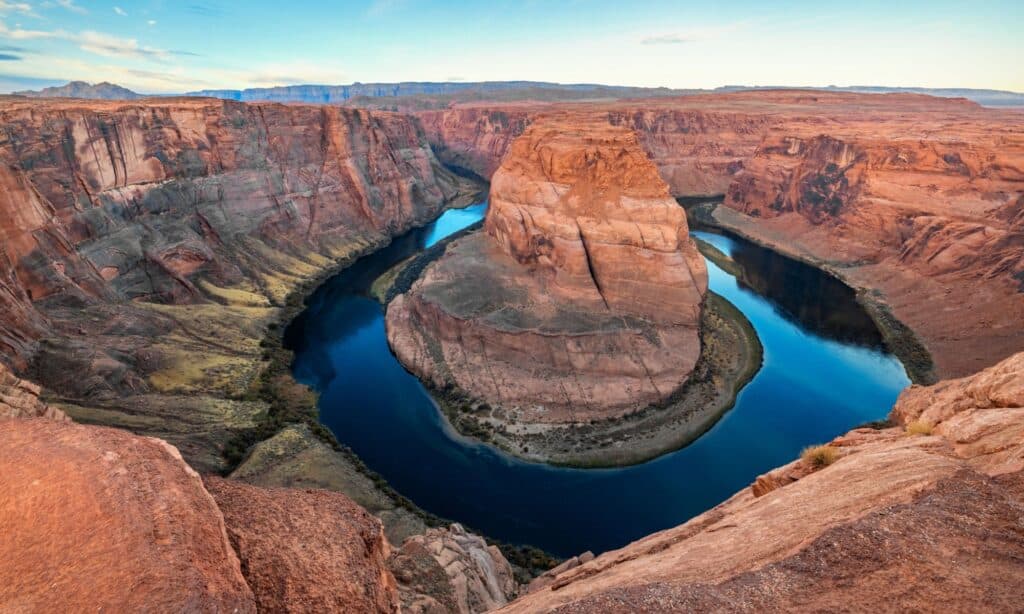
Lebid Volodymyr/Shutterstock.com
The Colorado River spans 2,334 kilometers (1,440 miles) from its start to the Gulf of California. It flows through seven western states: Arizona, California, Colorado, Nevada, New Mexico, Utah, and Wyoming. All seven states that this river flows through depend on its water supply, fish, hydropower production, and other benefits. The river also flows through eleven national parks, including the Grand Canyon National Park, Rocky Mountain National Park, Arches National Park, and more. Its 25 important tributaries, including Green, Little Colorado, Gila, White, Yampa, and San Juan, provide water for millions in the seven states it flows through.
Does the Colorado River have any unique features?
The Colorado River is best known for flowing through beautiful canyons and having whitewater rapids perfect for various activities. One of its most prominent sights was the Hoover Dam, built between 1931 and 1936 to control the river. The Hoover Dam provides water for Lake Mead, an artificial reservoir built to provide more water supply for Arizona, Nevada, California, and northern Mexico. It is deemed one of the world’s largest water reservoirs and is essential in maintaining industrial water and irrigation water for downstream residents to use.
What does the wildlife look like in the Colorado River?
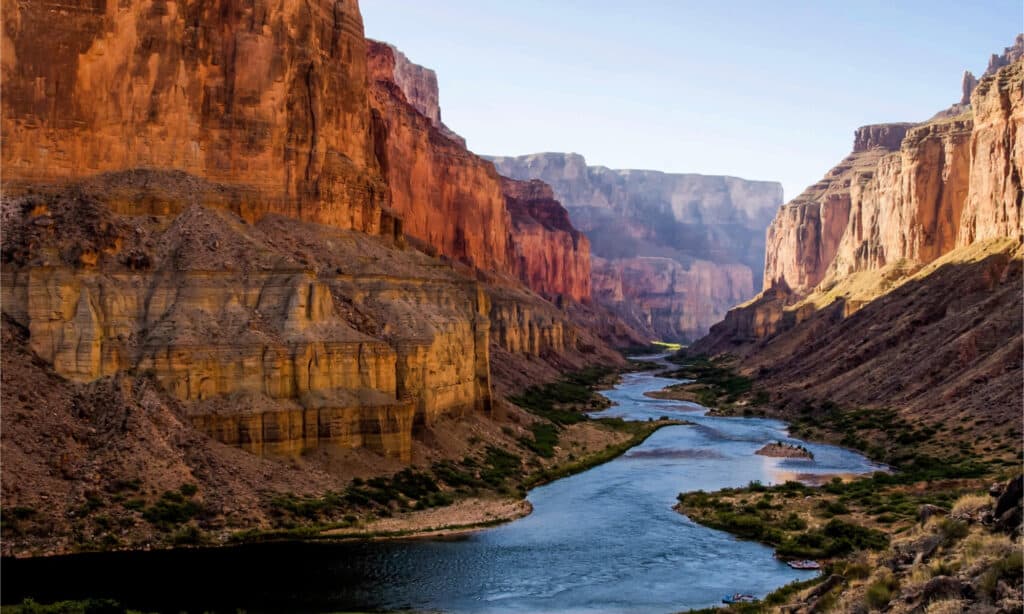
Beth Ruggiero-York/Shutterstock.com
In the environment and waters of the Colorado River, it is no surprise that it’s also home to a diverse number of species. In the Grand Canyon alone, many species of animals are already thriving in its areas. 447 species of birds, 91 mammals, 48 reptiles, 10 species of amphibians, and hundreds of invertebrates like spiders make the Grand Canyon their home.
The wildlife in the Colorado River consists of:
Mammals
The beaver is the most seen and largest mammal in the Colorado River. Since the river has a forceful flow, beavers build dams along the river banks. On the other hand, muskrats may also be found building dens along the river’s shorelines. River otters were mammals that once made the river their home, but after a few disappearances already, they have moved to another habitat. Several numbers of mule deer, bighorn sheep, coyotes, bobcats, and gray foxes can also be found along the river corridors.
Fish
Even if many fish species are wiped out by its cooling water, the Colorado River still boasts several fish thriving in its chilly waters. Some of the fish include smallmouth and largemouth bass, catfish, bluegill, rainbow trout, and crappie, which are usually the ones that are caught in sports fishing. Native species of fish that can adapt to its cool waters are minnows, speckled dace, and bluehead suckers.
Birds
The Colorado River often serves as a travel corridor or habitat for many migratory birds and waterfowl, like the great blue heron, the American avocet, the American wigeon, the red-winged blackbird, the western bluebird, the burrowing owl, the Mexican spotted owl, and the southwestern willow flycatcher.
Reptiles & Amphibians
The National Park Service reports approximately 47 reptile species in the Grand Canyon, with reported sightings of reptiles within the Colorado River itself. Reptiles and amphibians that thrive in the river waters include the western painted turtle, rattlesnake, sidewinder, gopher snake, short-horned lizard, red-spotted toad, and common kingsnake.
What are some other facts about the Colorado River?
- The Colorado River is approximately six million years old.
- Eight thousand years ago, hunter-gatherers inhabited the Colorado River as their only source of food and water.
- The river is one of the most utilized globally because of the amount of water flowing through it, which allows it to be used for many purposes. It currently has 29 dams, channels, and aqueducts that serve many great purposes other than recreation.
- There is a famous spot within the river called the Horseshoe Bend, a massive piece of rock placed in the middle of the river in the shape of a horseshoe.
- The river was first discovered in 1539 by a European named Francisco de Ulloa.
- Because of its recreational water opportunities, the Colorado River is called the “Granddaddy of rafting trips.”
- Human activity has dramatically altered the river and will remain controlled for various purposes.
Learn about the depth of the Columbia River.
More from A-Z Animals
The “Lifeline of the Southwest,” as it is known, the Colorado River is the sixth-longest river in the U.S. It rises in the Colorado and Wyoming snowcapped mountains and provides hydroelectric power and water for about 40 million people in the United States and Mexico. Due to its purpose for so many uses, it is also considered one of the world’s most heavily regulated rivers.
Tourists sailing along the Colorado River constantly ask the Grand Canyon river guides a recurring question; “How deep is the Colorado River?” It sounds like a simple question, but the answer has always remained unknown as researchers and scientists still debate over the river’s actual depth.
For today’s article, we’re going to delve deeper into one of the most important rivers in the country and will try to discuss how deep it is as well as its history, wildlife, and other unique features.
What is the actual depth of the Colorado River?

Enrique Alcala/Shutterstock.com
Researchers and scientists are still trying to come up with more definitive conclusions about the Colorado River’s depth. Even the Grand Canyon river guides couldn’t come up with an answer when tourists asked them the question. When people look up the internet, the responses vary based on the year and how truthful the information is. New studies suggest more accurate solutions based on the actual depth of the river.
It is said that the average depth of the Colorado River is about 20 feet, yet there are holes underneath its surface that go as deep as 90 feet. Other places in the river are just 6 feet deep, where there are rapids and calm water combined. With the use of various modern technologies such as aerial photography and multibeam sonar sensors dropped into the water, they can record elevation points in the riverbed.
A network of about 1,500 survey benchmarks along the Colorado River collected data about the river over time, allowing researchers to detect river depth changes. A geologist at Northern Arizona University and the leader of the survey project, Matt Kaplinski, presented his collected data that shows the river is 25 feet in depth, with the deepest going to 87 feet.
From Phantom Ranch to National Canyon, the researchers will keep mapping 240 miles of the Colorado River to collect more data and eventually provide a more precise and accurate representation of the river’s depth.
How long is the Colorado River?

Lebid Volodymyr/Shutterstock.com
The Colorado River spans 2,334 kilometers (1,440 miles) from its start to the Gulf of California. It flows through seven western states: Arizona, California, Colorado, Nevada, New Mexico, Utah, and Wyoming. All seven states that this river flows through depend on its water supply, fish, hydropower production, and other benefits. The river also flows through eleven national parks, including the Grand Canyon National Park, Rocky Mountain National Park, Arches National Park, and more. Its 25 important tributaries, including Green, Little Colorado, Gila, White, Yampa, and San Juan, provide water for millions in the seven states it flows through.
Does the Colorado River have any unique features?
The Colorado River is best known for flowing through beautiful canyons and having whitewater rapids perfect for various activities. One of its most prominent sights was the Hoover Dam, built between 1931 and 1936 to control the river. The Hoover Dam provides water for Lake Mead, an artificial reservoir built to provide more water supply for Arizona, Nevada, California, and northern Mexico. It is deemed one of the world’s largest water reservoirs and is essential in maintaining industrial water and irrigation water for downstream residents to use.
What does the wildlife look like in the Colorado River?

Beth Ruggiero-York/Shutterstock.com
In the environment and waters of the Colorado River, it is no surprise that it’s also home to a diverse number of species. In the Grand Canyon alone, many species of animals are already thriving in its areas. 447 species of birds, 91 mammals, 48 reptiles, 10 species of amphibians, and hundreds of invertebrates like spiders make the Grand Canyon their home.
The wildlife in the Colorado River consists of:
Mammals
The beaver is the most seen and largest mammal in the Colorado River. Since the river has a forceful flow, beavers build dams along the river banks. On the other hand, muskrats may also be found building dens along the river’s shorelines. River otters were mammals that once made the river their home, but after a few disappearances already, they have moved to another habitat. Several numbers of mule deer, bighorn sheep, coyotes, bobcats, and gray foxes can also be found along the river corridors.
Fish
Even if many fish species are wiped out by its cooling water, the Colorado River still boasts several fish thriving in its chilly waters. Some of the fish include smallmouth and largemouth bass, catfish, bluegill, rainbow trout, and crappie, which are usually the ones that are caught in sports fishing. Native species of fish that can adapt to its cool waters are minnows, speckled dace, and bluehead suckers.
Birds
The Colorado River often serves as a travel corridor or habitat for many migratory birds and waterfowl, like the great blue heron, the American avocet, the American wigeon, the red-winged blackbird, the western bluebird, the burrowing owl, the Mexican spotted owl, and the southwestern willow flycatcher.
Reptiles & Amphibians
The National Park Service reports approximately 47 reptile species in the Grand Canyon, with reported sightings of reptiles within the Colorado River itself. Reptiles and amphibians that thrive in the river waters include the western painted turtle, rattlesnake, sidewinder, gopher snake, short-horned lizard, red-spotted toad, and common kingsnake.
What are some other facts about the Colorado River?
- The Colorado River is approximately six million years old.
- Eight thousand years ago, hunter-gatherers inhabited the Colorado River as their only source of food and water.
- The river is one of the most utilized globally because of the amount of water flowing through it, which allows it to be used for many purposes. It currently has 29 dams, channels, and aqueducts that serve many great purposes other than recreation.
- There is a famous spot within the river called the Horseshoe Bend, a massive piece of rock placed in the middle of the river in the shape of a horseshoe.
- The river was first discovered in 1539 by a European named Francisco de Ulloa.
- Because of its recreational water opportunities, the Colorado River is called the “Granddaddy of rafting trips.”
- Human activity has dramatically altered the river and will remain controlled for various purposes.
Learn about the depth of the Columbia River.

